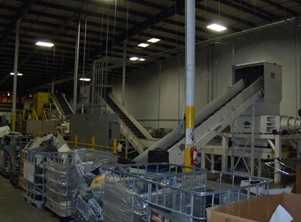What Happens at Work Doesn’t Always Stay at Work; Lead Exposure from an E-Scrap Recycling Facility Can Transfer to the Home
July 16, 2015
NIOSH Update:
Contact: Nura Sadeghpour (202) 245-0673
Recycling of used electronics (E-scrap) is an emerging area of concern as a source of occupational exposures among workers and a source of take-home exposures. In an evaluation of an Ohio e-scrap facility, described in this week’s Morbidity and Mortality Weekly Report (MMWR), researchers at the National Institute for Occupational Safety and Health (NIOSH) found that take-home contamination and lead exposure can occur when dust is transferred from the workplace to the home.
Recycling e-scrap is a newly recognized source of exposure to lead in the U.S. In a 2012 health hazard evaluation at an e-scrap facility in Ohio, NIOSH found that take-home contamination can occur when contaminants are transferred from the workplace on employee’s skin, clothing, shoes and other personal items to their car and home.
“As we learn more about whether workers are exposed to hazards and harmful conditions on the job it is important to determine what employers and workers can do to prevent not only exposures at work but take-home exposures that affect family and loved ones,” said NIOSH medical officer Elena Page MD, MPH. “Healthcare providers should ask parents about their jobs and assess the risk of exposure to a variety of substances found in occupational settings.”
During the evaluation, NIOSH investigators tested the facility for lead through air and surface sampling. Wipe samples were taken from work surfaces, production areas, conference room supply air duct, break rooms and water fountains as well as from the hands of 12 employees before they left work. The hands of 8 of 12 employees tested positive for lead, even though they had washed their hands with soap and water prior to testing. NIOSH also took wipe samples from uniforms of employees’ front shoulder area. Twelve of 13 uniforms tested positive for lead. Earlier, in 2010, two cases of child lead poisoning in a home linked with this facility had been confirmed by the Cincinnati Health Department and Cincinnati Children’s Hospital Pediatric Environmental Health Specialty Unit.
As a result of this evaluation, NIOSH recommended steps for the company and employer to take to prevent take-home exposures, including:
- reducing exposure in the workplace
- changing clothes and shoes before going home and leaving soiled clothing at work for laundering
- storing street clothes in separate areas of the workplace to prevent contamination
- showering before leaving work
- prohibiting removal of toxic substances or contaminated items from the workplace
Preventing take-home exposure is key because decontaminating homes and vehicles is not always effective in the long term. Normal house cleaning and laundry methods are not enough to reduce the hazard, and decontamination activities can potentially lead to hazardous exposures. The findings from the evaluation and recommendations for reducing exposures were shared with the employer and employees.
To read the full report, Investigation of Childhood Lead Poisoning from Parental Take-Home Exposure from an Electronic Scrap Recycling Facility –— Ohio, 2012, please visit: http://www.cdc.gov/mmwr/preview/mmwrhtml/mm6427a3.htm?s_cid=mm6427a3_e. For more information on occupational exposures at e-scrap facilities via the NIOSH Science Blog, please visit: http://blogs.cdc.gov/niosh-science-blog/2014/09/30/escrap/.
NIOSH is the federal agency that conducts research and makes recommendations for preventing work-related injuries, illnesses, and deaths. For more information about NIOSH visit http://www.cdc.gov/niosh/.
- Page last reviewed: July 16, 2015
- Page last updated: July 16, 2015
- Content source:
- National Institute for Occupational Safety and Health Education and Information Division


 ShareCompartir
ShareCompartir
